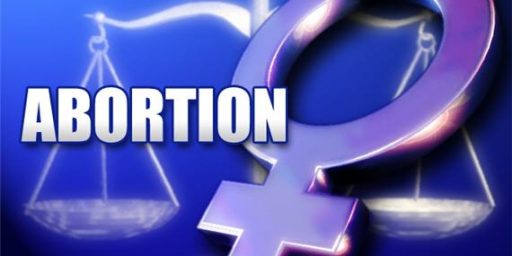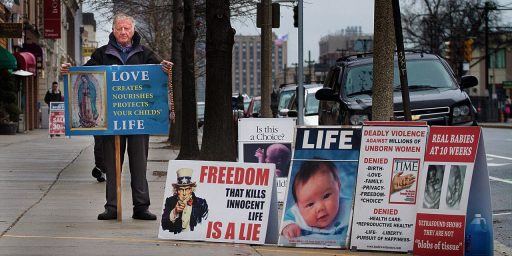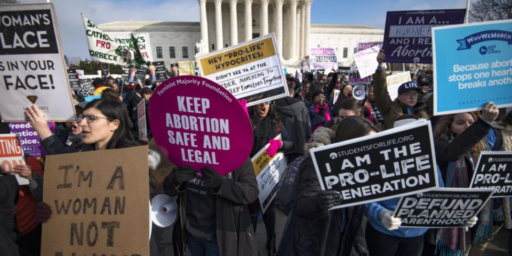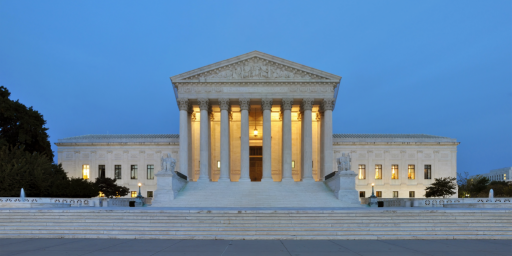Divided Supreme Court Hears Argument In Texas Abortion Case
The Supreme Court seems as closely divided as ever on an issue that has divided the nation for forty years, but the implications of Justice Scalia's death were quite apparent during oral argument in the Texas Abortion Law case.
Abortion has been an issue on which the Supreme Court has been as divided as the American public from virtually the time that the Court’s decision in Roe v. Wade was handed down more than forty years ago, and today’s argument in Whole Woman’s Health v. Hellerstedt, a case dealing with a series of new regulations that Texas is seeking to impose on abortion clinics in the state, makes it clear that those division remain as alive and well as ever even in the wake of the death of Justice Antonin Scalia:
WASHINGTON — The Supreme Court on Wednesday appeared sharply and perhaps evenly divided in its first major abortion case in almost a decade, one that has the potential to revise constitutional standards and to affect millions of women.
Several justices seemed frustrated by gaps in the factual record presented to them. The three more conservative justices said there was little evidence that clinics have closed or would close because of the law.
Justice Anthony M. Kennedy, who almost certainly holds the crucial vote, mused that it might be useful to return the case to the lower courts to develop more evidence. He said it would help to know how many abortions could be performed in the clinics that would remain open if a restrictive Texas law was allowed to become fully effective.
The court’s four liberal justices were adamant that the restrictions imposed by the law served no medical purpose and cannot pass constitutional muster.
Justice Antonin Scalia’s death last month may have muted the prospect of truly bold action, but even a 4-to-4 tie would have enormous consequences because it would leave in place an appeals court decision that could drive down the number of abortion clinics in Texas to about 10, from roughly 40.
The case is one of the most consequential on the docket this term, and that was reflected by a huge, boisterous crowd that gathered on the sidewalk in front of the Supreme Court before the arguments started, filling the air with the voices of activists who were braving a stiff wind and biting cold.
(…)
The court’s last abortion decision, in 2007 in Gonzales v. Carhart, upheld the federal Partial-Birth Abortion Ban Act, which banned a particular abortion procedure. The new case, Whole Woman’s Health v. Hellerstedt, No. 15-274, concerns a more fundamental question and may turn out to be the third installment in a legal trilogy on the scope of the constitutional right to abortion — one that started in 1973 with Roe v. Wade, which recognized a constitutional right to abortion, and continued in 1992 with Planned Parenthood v. Casey.
The Casey decision said states were not permitted to place undue burdens on the constitutional right to an abortion before the fetus was viable. Undue burdens, it said, included “unnecessary health regulations that have the purpose or effect of presenting a substantial obstacle to a woman seeking an abortion.”
The new case concerns two parts of a Texas law that imposes strict requirements on abortion providers. It was passed by the Republican-dominated Texas Legislature and signed into law in July 2013 by Rick Perry, the governor then.
One part of the law requires all clinics in the state to meet the standards for “ambulatory surgical centers,” including regulations concerning buildings, equipment and staffing. The other requires doctors performing abortions to have admitting privileges at a nearby hospital.
The clinics challenging the law say it has already caused about half of the state’s 41 abortion clinics to close. If the contested provisions take full effect, they say, the number of clinics would again be halved.
The remaining clinics would be clustered in four metropolitan areas: Austin, Dallas-Fort Worth, Houston and San Antonio.
“None is located west or south of San Antonio, a vast geographic area that is larger than California,” a brief for the clinics said.
The United States Court of Appeals for the Fifth Circuit allowed a partial exemption for a clinic in McAllen, in South Texas, the brief added, but “imposed limitations on the clinic’s operational capacity that would severely restrict its ability to provide abortions.”
Officials in Texas said that the contested provisions were needed to protect women’s health, but abortion providers responded that the regulations were expensive, unnecessary and intended to put many of them out of business.
The lower courts are divided over whether they must accept lawmakers’ assertions about the health benefits of abortion restrictions at face value or instead determine whether the assertions are backed by evidence.
In June, the Fifth Circuit, in New Orleans, largely upheld the contested provisions of the Texas law, using the more deferential approach. The court ruled that the law, with minor exceptions, did not place an undue burden on the right to an abortion.
The court said women in West Texas could obtain abortions in New Mexico, a ruling in tension with one from a different panel of the same court that said Mississippi could not rely on out-of-state abortion clinics in defending a law that would have shut down the state’s only clinic.
In November, the federal appeals court in Chicago used a more demanding standard in evaluating a Wisconsin law requiring abortion doctors to have admitting privileges at local hospitals. Judge Richard A. Posner, writing for the court, said the state’s justification for the law did not withstand scrutiny.
“The requirement of admitting privileges cannot be taken seriously as a measure to improve women’s health,” he wrote, “because the transfer agreements that abortion clinics make with hospitals, plus the ability to summon an ambulance by a phone call, assure the access of such women to a nearby hospital in the event of a medical emergency.”
In November, the federal appeals court in Chicago used a more demanding standard in evaluating a Wisconsin law requiring abortion doctors to have admitting privileges at local hospitals. Judge Richard A. Posner, writing for the court, said the state’s justification for the law did not withstand scrutiny.
“The requirement of admitting privileges cannot be taken seriously as a measure to improve women’s health,” he wrote, “because the transfer agreements that abortion clinics make with hospitals, plus the ability to summon an ambulance by a phone call, assure the access of such women to a nearby hospital in the event of a medical emergency.”
Lyle Denniston summarizes the arguments, and especially Justice Kennedy’s suggestion that the case be remanded for further development of the factual record:
It was unmistakably clear on Wednesday that the Supreme Court’s first close look at abortion rights in nine years will turn on the reaction of Justice Anthony M. Kennedy, and there were at least sturdy hints that he would lead the Court in one of two directions. In an intense argument in Whole Woman’s Health v. Hellerstedt that ran twenty-six minutes longer than scheduled, Kennedy seemed poised to find a way out of a four-to-four split — if the initial vote comes to that — or to strike down by a narrow vote the two restrictions at issue in the 2013 Texas law, known as “HB2.”
Within minutes after the argument began shortly after ten o’clock, it seemed that the case might bog down in a dispute about whether the case contains any solid evidence of whether HB2 was, in fact, the cause for the sudden closing of half of all abortion clinics in the state and would cause even more to close if the Justices upheld the law’s two main clauses. The two are a requirement that all abortion doctors have a professional privilege to admit patients to a nearby hospital, and a requirement that all abortion clinics upgrade to facilities capable of performing surgery. There was even some question about whether the admitting privilege was still at issue.
But when the argument turned from the reason for closures to a question of the capacity of any remaining clinics to handle the tens of thousands of abortions that women in the state seek every year, the case shifted abruptly. It was Kennedy who raised the possibility that the case be sent back to lower courts to allow lawyers to put in evidence about that capacity question.
Several things immediately seemed important about that suggestion.
First, it would allow the Court to avoid a decision about the validity of either part of the Texas law, if it should turn out that, at Friday’s planned discussion of the case in a private Conference, the initial vote came out split four to four (the late Justice Antonin Scalia was a fervent foe of abortions). Returning the case for gathering of new evidence would avoid that outcome — indeed, any immediate outcome — and thus would avoid the even division that settles nothing and always disappoints the Court. It might even put off the case until the current vacancy on the bench is filled with a new Justice.
Second, of equal or perhaps even greater importance, there may have been a logical basis for that suggestion and it could have been in Kennedy’s mind. If he had any inclination to uphold either or both of the provisions, Kennedy would understand that this would probably lead to a four-to-four tie. But taking that position would mean he had done so without knowing whether the capacity of the remaining clinics — nine or ten at most — would be enough to handle all abortions that would be sought in the state (recently, between 60,000 and 75,000 a year)? Thus Kennedy might hesitate even more to push the Court into a tie vote.
Third, Kennedy’s hesitation on taking a stand on the merits of the law seemed even more likely because of a question he asked later in the argument. He pressed the lawyer for Texas, state Solicitor General Scott A. Keller, on whether the enforcement of the two provisions would actually lead more women to have more abortions through surgery, by forcing them to wait, with more risk than having an earlier abortion through the use of drugs that induce termination of pregnancy (“medical abortion”).
Kennedy cited data that the number of drug-induced abortions had increased nationally, but the number in Texas was down, and he commented that “this may not be medically wise.” The abortion clinics and doctors who are challenging the Texas laws have made that prospect a part of their argument that the two provisions impose an unconstitutional burden on Texas women’s constitutional right to seek an abortion, and Kennedy appeared to have taken that seriously.
Returning the case to lower courts to get more evidence on the incidence of later abortions might be one way to deal with that prospect, but so would striking down the law — by a five-to-three vote — because of the negative consequences of inducing more mid-term abortions. Since Roe v. Wade, the Court (including Kennedy since he joined the bench) has always been more comfortable with earlier abortions, partly because they are safer but also because of a concern for protecting the developing life of the fetus. Kennedy was a key part of the Court’s compromise ruling in 1992 (Planned Parenthood of Southeastern Pennsylvania v. Casey) when the Court expressed new support for state power to protect potential life, an interest that was said to increase the longer a pregnancy continues.
Kennedy’s suggestion that the case should be remanded for further evidence gathering would be one way for the Court to deal with the seeming 4-4 division that Justice Scalia’s death created on this issue, of course, but it’s not necessarily clear that this is likely to happen in this particular case. For one thing, the presumption of a 4-4 division, which would leave the lower court ruling upholding the Texas law standing but not create a precedent that, theoretically, would chip away significantly at the central holding in Roe v. Wade and its progeny. Indeed, as Ian Millhiser notes, Justice Scalia’s death appears to make it unlikely that this outcome will happen in this or any future abortion case unless a Republican is elected President in November, that Justice Kennedy sticks with the conservatives on this issue as he has in the past, and the Court gets another abortion case before there was any further change in the make-up of the Court. The other possibility, of course, is that Kennedy ends up siding with the liberal side of the court, making for a 5-3 outcome striking down the laws under what would likely be a limited ruling that relies on Roe and Casey rather than trying to break any new ground. Such a ruling would have a significant national impact, though, given the fact that several states with Republican-controlled legislatures have adopted regulations similar to those at issue in the Texas case, many of which are presently being challenged in various Federal Courts around the country. A Supreme Court ruling striking down the Texas law would, undoubtedly mean that these state laws would also be struck down.
Beyond Justice Kennedy’s musings about remanding the case, Denniston notes that argument and questions followed the expected path:
Going into Wednesday’s argument, it was already clear that the Justices disagreed deeply about the enforcement of the Texas law. The Court split five to four in last June in limiting enforcement of the law, and the line-up then was quickly evident by comments and questions from the bench by all of the Justices (except Justice Clarence Thomas, who did not say anything).
The four more liberal members of the Court — Justices Stephen G. Breyer, Ruth Bader Ginsburg, Elena Kagan, and Sonia Sotomayor — energetically challenged the lawyer for Texas, and often did so in words that denounced what the Texas legislature could have been thinking in passing the restrictions. Justice Sotomayor was so diligent that she even went on with questions after Chief Justice John G. Roberts, Jr., signaled that the lawyer then at the lectern was finished.
On the other side, the Chief Justice and Justice Samuel A. Alito, Jr., were dogged in tough questions to Stephanie Toti of New York City, a lawyer for the Center for Reproductive Rights, speaking for the abortion clinics. Alito, in particular, tried a variety of tactics to try to shore up the law’s legality, and to question the challenge to it.
As always, it is generally not a good idea to try to draw conclusions from oral argument or the questions that Justices ask during oral argument. That being said, it’s obvious that there are four Justices who would vote to strike down the law based on Roe, Casey, and the general idea that the regulations contemplated by the Texas law and others like are are more about seeking to restrict access to a legal abortion than they are about reasonable regulation of a medical procedure. On the other side, it’s equally clear that there are three Justices who would vote to uphold the law as a proper exercise of the state’s regulatory authority, and who would likely sign on to an opinion that chipped away significant at Roe and its progeny. Without Justice Scalia, though, this wing of the Court is at a distinct disadvantage in that the best they can hope for is that the lower court ruling would be upheld if Justice Kennedy joins them, which doesn’t appear to be certain by any means. Indeed, if the liberal wing of the court were willing to agree to a narrow enough holding it seems possible that there could be a 5-3 majority to strike the law down altogether, something that would significantly change the politics and the legal status of abortion in the United States.
In any event, this is likely a case where we won’t learn the ultimate outcome until very near the end of the Court’s term in June. Until then, it’s all just a matter of waiting to see which side of the argument Justice Kennedy ends up siding with, or whether the Court as a whole ends up signing off on Kennedy’s suggestion that the case could be punted back to the trial court at which point it likely wouldn’t return to the Supreme Court until well after Justice Scalia’s replacement is seated, even if we have to wait for the next President for that to happen.
Here’s the transcript of today’s argument:






After reading the transcript, the only question in my mind is whether Sotomayor or Kagen are the ones to state clearly that the Texas’s legislature claim that they are acting to protect women’s health is literally unbelievable.
@SKI: But it was Ginsburg who absolutely destroyed the claim. On the one hand, the law’s defenders say this is critical for the health of the women, so we need these stringent requirements. On the other hand, they suggest going to New Mexico for an abortion, where the stringent requirements don’t even exist.
@Franklin: yup but I’m not sure she will be caustic enough to say that out loud in an opinion
Small government Republicans trying to use Government to impose their will on women.
Because there is something in their body that doesn’t have a fully developed brain…and Republicans need those voters.
@SKI: Just to be clear, she did say that out loud while questioning Texas Solicitor General Scott Keller:
“So if your argument is right,” Ginsburg continued, “then New Mexico is not an available way out for Texas, because Texas says: To protect our women, we need these things. But send them off to New Mexico,” to clinics with more lenient standards, “and that’s perfectly all right.”
It seems blindingly obvious that Texas is acting in bad faith. One would think that would count against them in court. But I guess the conservative justices, SCOTUS and lower, are happy to go along with the con.
My major take away after reading the oral arguments is that SCOTUS needs two more women as justices.